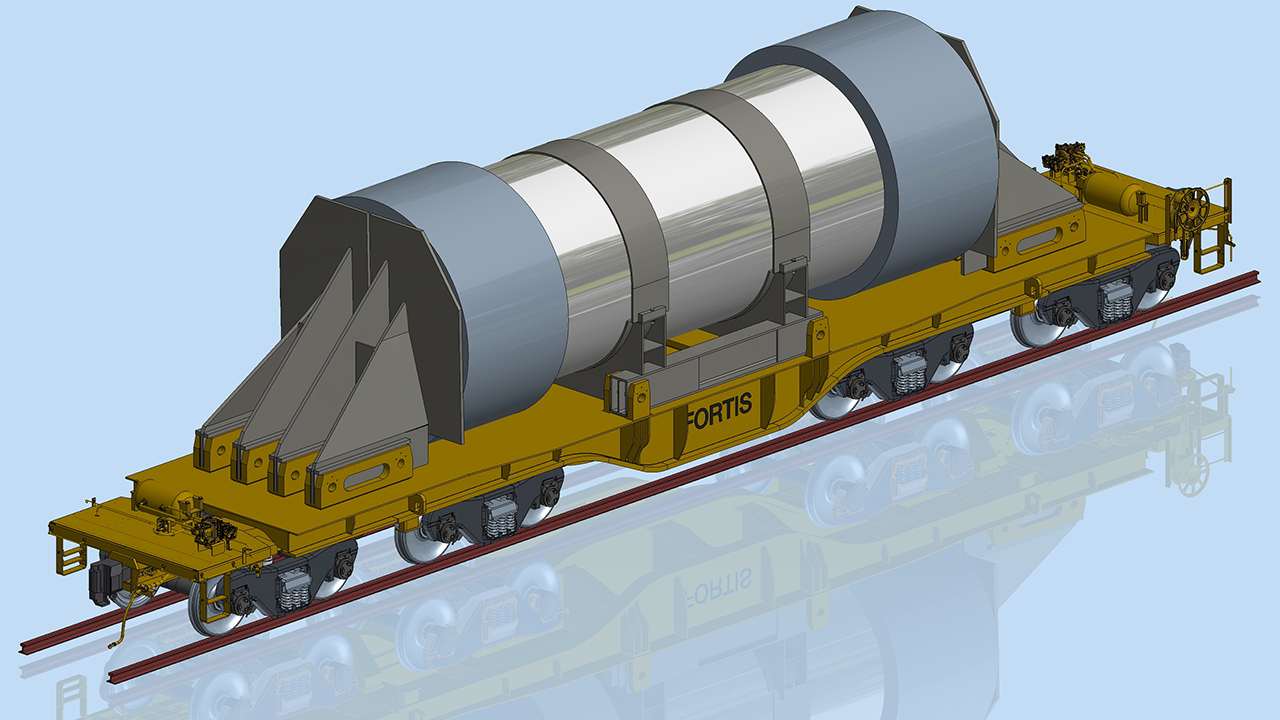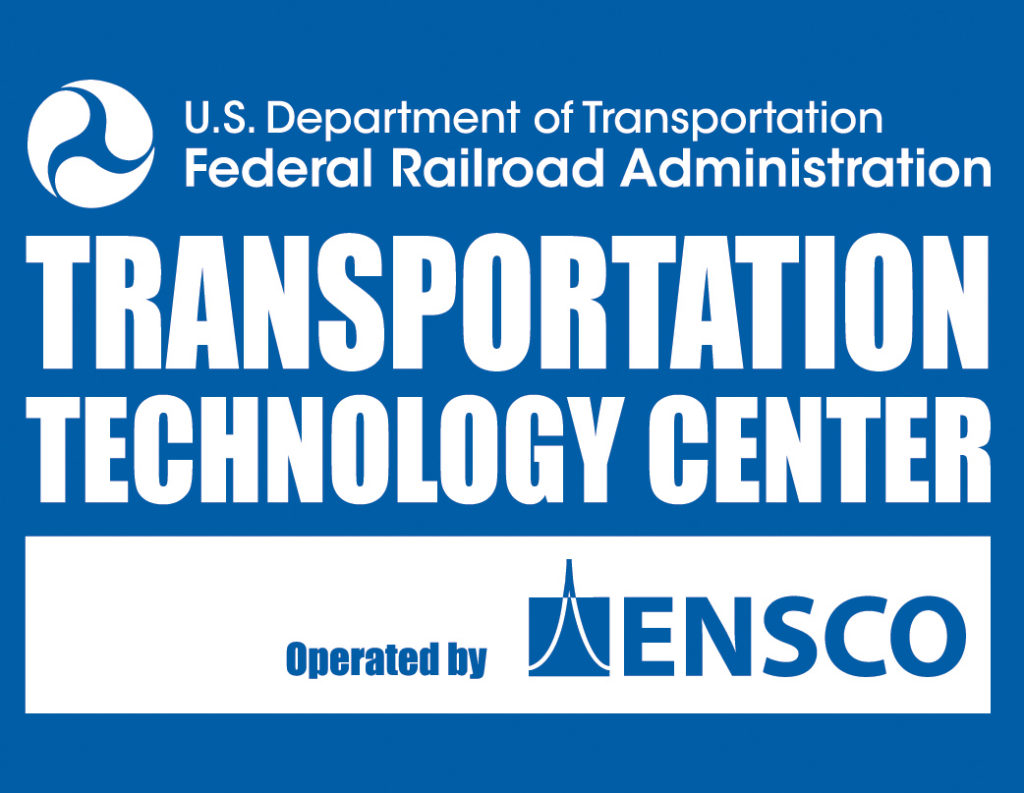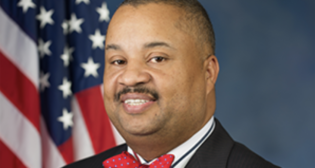
Fortis Prototype Fabrication and Testing
Written by Przemyslaw Rakoczy, Senior Research Engineer, ENSCO, Inc., and Matthew Dick, P.E., Chief of Strategy & Development, ENSCO, Inc.
Department of Energy prototype Fortis eight-axle cask-carrying railcar design. (TTC Operated by ENSCO)
TTC OPERATED BY ENSCO, RAILWAY AGE APRIL 2023 ISSUE: Discover a new railcar for transporting spent nuclear fuel and high-level radioactive waste.
The United States currently has 92 nuclear power reactors at 53 power plants in operation providing 19% of the nation’s power supply. Nuclear power generation has the benefit of not directly producing carbon emissions like coal and natural gas, but it does produce nuclear waste byproducts that must be safely transported, stored and eventually disposed of. This article describes the U.S. Department of Energy (DOE) Fortis spent nuclear fuel cask-carrying railcar project that is being performed by ENSCO via DOE Contract 89243222CNE000026.
Nuclear Byproducts
Spent nuclear fuel (SNF) is radioactive material, such as uranium, that has been used in a nuclear reactor to generate electricity. At the end of its service life, it is no longer useful in sustaining a nuclear reaction so it must be safely stored until it can be permanently disposed of. Currently, most SNF is safely stored in specially designed spent fuel pools or dry storage casks at individual reactor sites around the country.
The DOE is responsible for the long-term disposition of SNF and high-level radioactive waste (HLW), including their associated transportation. DOE is currently pursuing federal consolidated interim storage for SNF that will reduce the number of sites SNF is stored at in the U.S., allow decommissioned nuclear power plants to be put to new industrial uses, and begin fulfilling the federal government’s responsibilities for disposition of SNF until a disposal solution is available. To contain the radioactive material for transportation, DOE uses Type B transportation casks, which are large, reinforced containers. These casks have been specifically designed to prevent the possibility of radioactive release, even in the event of a collision, and are certified in accordance with 10 CFR Part 71, issued by the Nuclear Regulatory Commission (NRC). Casks can weigh up to 240 tons when loaded, including the shipping cask, cradle, impact limiters and end stops. Because of the size and weight of the casks, transporting by rail is the safest and most economical transportation method.
Cask Railcars
Currently, there are three cask-carrying railcars designed for transporting SNF in North America. The first two are a twelve-axle railcar developed by the U.S. Navy, and a twelve-axle railcar, named Atlas, developed by DOE. The third, and the focus of this article, is an eight-axle railcar, named Fortis, also developed by DOE.
The Fortis railcar has been designed by DOE Contractor Sharma and Associates to comply with the Association of American Railroads (AAR) Performance Specification for Trains Used to Carry High-Level Radioactive Material (HLRM) – Standard S-2043, which is a part of the Manual of Standards and Recommended Practices – Car Construction Fundamentals and Details. This standard establishes performance guidelines for trains carrying SNF and HLW on AAR railroads (HLRM is an AAR-specific term and is understood to mean SNF and HLW). S-2043 specifies three railcar development phases, which include preliminary design and analysis, prototype testing, and final design and analysis.
The Fortis railcar has finished the first phase—preliminary design and analysis. The AAR Equipment Engineering Committee (EEC) approved the initial design, and the prototype Fortis railcar was allowed to proceed to fabrication and testing. ENSCO partnered with Kasgro Rail Corp. (Kasgro) for fabrication of the railcar, Oak Ridge Technologies (ORT) for cask-mounting hardware, and RailcarCO Corp. for project support. After fabrication is complete, the railcar will be transported to the Federal Railroad Administration Transportation Technology Center (TTC) in Pueblo, Colo., for extensive testing according to S-2043.
S-2043 Standard
S-2043 includes static and dynamic vehicle tests from the AAR Manual of Standards and Recommended Practices, Section C, Part II, Chapter XI standard. Chapter XI is famously the gold standard for defining freight railcar qualification testing to enable a new railcar design to operate through interchange on AAR railroads. S-2043 tightens the performance requirements for many Chapter XI tests and includes additional requirements to help put a greater focus on derailment risk reduction.
S-2043 testing includes single-car tests and multiple-car tests. The single-car tests are designed to evaluate and characterize the prototype vehicle as well as its components. This includes, but is not limited to, truck suspension characterization, structural tests, vehicle dynamic performance tests and brake tests. Multiple-car tests are designed to verify that the individual railcars in the consist do not adversely affect the performance of the train consist. These tests include train consist braking tests, buff and draft curving, as well as system monitoring tests and ride quality. All single-car and multiple-car tests and subsequent data analysis will be witnessed by a qualified AAR observer.
Testing at the TTC
After arrival of the Fortis railcar at the TTC, ENSCO’s experienced instrumentation and engineering team will instrument the railcar according to previously developed and approved Test Implementation Plans (TIP). The instrumentation includes Instrumented Wheelsets (IWS), which measure the wheel/rail contact forces and ensure that the vehicle does not exceed derailment risk criteria. Additionally, strain gauges will be installed to measure stresses in the railcar structure. Accelerometers and displacement transducers will be installed to measure vehicle dynamics performance.
The TTC is equipped with all the necessary facilities and test tracks required for AAR S-2043 and Chapter XI testing and certification. TTC’s Wheel Rail Mechanism Loop (WRM) is a 7.5-mile loop with 4-, 5-, 7.5-, 10- and 12-degree curves where the Chapter XI Dynamic Curving testing is conducted. Dynamic Curving is arguably one of the most challenging vehicle dynamics tests of the standard because it is designed to fully exercise the railcar’s suspension to identify potential derailment risk. The Precision Test Track (PTT) has intentional track perturbations necessary for S-2043 and Chapter XI vehicle dynamics testing for pitch and bounce, twist and roll, and yaw and sway.
In addition to the on-track testing capabilities, the TTC has the Rail Dynamics Laboratory (RDL) with full-scale lab testing equipment to evaluate rail vehicles in a laboratory setting. Testing of the Fortis prototype railcar will utilize TTC’s Mini-Shaker Unit (MSU), which is equipped with 13 hydraulic actuators that can apply a maximum of 210 kips to the railcar in a dynamic manner and at different frequencies to assess truck vertical, lateral, roll and yaw performance, truck yaw resistance, and railcar component testing. The Squeeze Test Fixture (STF) will be used for the compression testing along the draft line and is capable of up to 2,600 kips of a compressive load to the whole vehicle for crush compliance testing and structural stress testing.

Conclusion
The TTC operated by ENSCO and its partners are aiding the DOE to fabricate and test an eight-axle spent nuclear fuel cask-carrying railcar. This project is the first of many where the TTC under ENSCO’s operation provides AAR qualification testing for future freight rolling stock.
Questions about the Office of Nuclear Energy’s programs, including railcar development projects, may be directed to [email protected].



